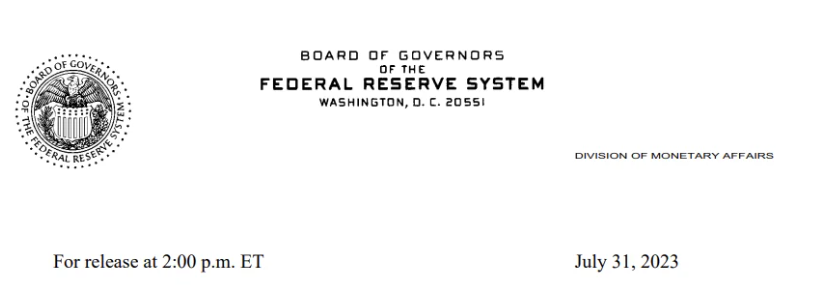July 2023 Senior Loan Officer Opinion Survey on Bank Lending Practices. Banks plan to further tighten lending standards across all loan types.

Why? Expected decline in collateral value, Anticipated decrease in credit quality, Predicted liquidity challenges, & Deposit Outflows.

https://www.federalreserve.gov/data/documents/sloos-202307-fullreport.pdf
Table 1 (PDF) | Table 2 (PDF) | Charts (PDF)
Wut Mean?:Commercial and Industrial (C&I) Lending:
- Banks tightened standards for C&I loans to businesses of all sizes.
- All loan terms for C&I loans, like rate spreads, premiums on riskier loans, credit line costs, and many others, were tightened.
Both large and other banks tightened C&I lending standards and terms similarly, with foreign banks also following the trend.
- The main reasons for tightening were concerns about the economy, increased risk aversion, liquidity issues, industry-specific challenges, legislative changes, and reduced secondary market liquidity.
Demand for C&I loans dropped, with both large and other banks experiencing similar decline rates. Fewer foreign banks saw this decline, but many banks noted fewer inquiries from potential borrowers.
- Reasons for weaker demand included reduced investment in facilities and equipment, decreased needs for financing inventories, mergers, acquisitions, and accounts receivables.
Commercial Real Estate (CRE) Lending:
- Banks tightened standards for all CRE loan categories, with both large and other banks showing similar tightening levels.
- Demand for CRE loans weakened, with other banks seeing a greater decline than large banks. Foreign banks also reported a decrease in demand and tighter standards.
Residential Real Estate (RRE) Lending:
- Banks tightened standards for all RRE loans and HELOCs during the quarter.
- Major tightening observed for non-QM jumbo residential loans and HELOCs.
- Moderate tightening for several other RRE loan categories like QM jumbo and subprime.
- Lesser tightening for GSE-eligible and government loans.
- Most banks saw decreased demand for RRE loans and HELOCs, but only a slight decrease in demand for subprime mortgages.
Consumer Lending:
- Banks tightened standards for credit card and other consumer loans; moderate tightening observed for auto loans.
- Banks made stricter requirements for credit card loans: higher minimum credit scores, reduced credit limits, and stricter granting processes.
- Auto loans saw increased rate spreads and more stringent credit score requirements.
- For other consumer loans, terms tightened through increased rate spreads and stricter credit requirements.
- Demand for credit card loans remained stable overall, but large banks saw a slight decrease in demand, while other banks noticed an increase.
- Declined demand observed for auto loans and other consumer loans in the second quarter.
Special questions:
The July 2023 survey, continuing a tradition since 2011, asked banks to compare current lending standards to a historical range since 2005.
C&I Loans:
- Most banks reported tighter lending standards than the midpoint of their historical ranges.
- This tightening was particularly noticeable among non-large banks for certain loan types.
- Compared to July 2022, lending standards have substantially tightened, moving from near or easier-than-midpoint to tighter.
- Foreign banks also echoed this trend, though standards for some loan types remained unchanged since last year.
CRE Loans:
- Most banks indicated tighter standards across all loan categories, a steeper trend than in 2022.
- Foreign banks paralleled this tightening sentiment.
RRE Loans:
- Banks reported tighter standards for most loan categories, particularly for GSE-eligible and government loans, which had been at the midpoint in 2022.
- HELOCs also saw significant tightening since 2022.
Consumer Loans:
- Tighter lending standards were noted across all consumer loan categories, notably for subprime credit card and auto loans.
- In contrast to 2022, even loans that had easier standards last year (like prime credit card and auto loans) are now on the tighter end.
Expectations for lending standards for the latter half of 2023, assuming the economy aligns with consensus forecasts:
- Banks plan to further tighten lending standards across all loan types.
Specific expectations:
- C&I Loans: Many banks anticipate stricter standards for business of any size.
- CRE Loans: A majority expect stricter standards for construction and nonfarm loans, with a sizable portion also expecting tightening for multifamily property loans.
- RRE Loans: Some banks predict tighter standards for GSE-eligible and nonconforming jumbo loans.
- Consumer Loans: Many banks foresee stricter standards for credit card and auto loans in 2023.
Reasons for the expected tightening include:
- Uncertain economic outlook.
- Expected decline in the value of collateral.
- Anticipated decrease in credit quality.
- Reduced risk tolerance.
- Predicted liquidity challenges.
- Concerns about funding costs, deposit outflows, and potential impacts of legislative or supervisory changes.
TLDRS:
The July 2023 Senior Loan Officer Opinion Survey on Bank Lending Practices showed the following:
Banks reported generally tighter lending standards and reduced demand for both commercial and industrial (C&I) loans and commercial real estate (CRE) loans in the second quarter.
- We have been covering commercial and industrial (C&I) loans
Lending standards became stricter for all types of residential real estate (RRE) loans, particularly those not backed by government agencies.
- Demand for RRE loans decreased, as did demand for home equity lines of credit (HELOCs).
- Lending standards for all consumer loans became stricter with reduced demand for auto and other loans, but demand for credit card loans remained unchanged--we have covered lending becoming stricter previously on the sub as well.
- Banks plan to further tighten lending standards across all loan types.
- Demand for credit card loans remained stable overall--so while banks are tightening, households still needing credit just as much.
Reasons for the expected tightening include:
- Uncertain economic outlook.
- Expected decline in the value of collateral.
- Anticipated decrease in credit quality.
- Reduced risk tolerance.
- Predicted liquidity challenges.
- Concerns about funding costs, deposit outflows, and potential impacts of legislative or supervisory changes.



